Use of Weapons: How Did IDPs Fare in 2016?
At this time of year we’re all fired up with the promise of youth. We’re going to rebuild our rosters and the hot young things we pick up in the fifth round of rookie drafts are going to be brilliant forever and win us titles.
Obviously that’s not always true, but there is a kernel of truth. We know that historically there are always some really good instant performers. At the same time, some teams like to avoid using young players. I wanted to delve into what success looks like for rookies in the IDP world and how they’re actually used.
[am4show have=’g1;’ guest_error=’sub_message’ user_error=’sub_message’ ]
Defensive Tackles
If you cast your mind back a year, you’ll remember we were all agreed it was a fantastic year for interior players. There were huge run-stuffers from Alabama, there were pass-rushers, there was everything you could want. We probably thought rookie DTs would play often and early. Here are their combined snaps by week:
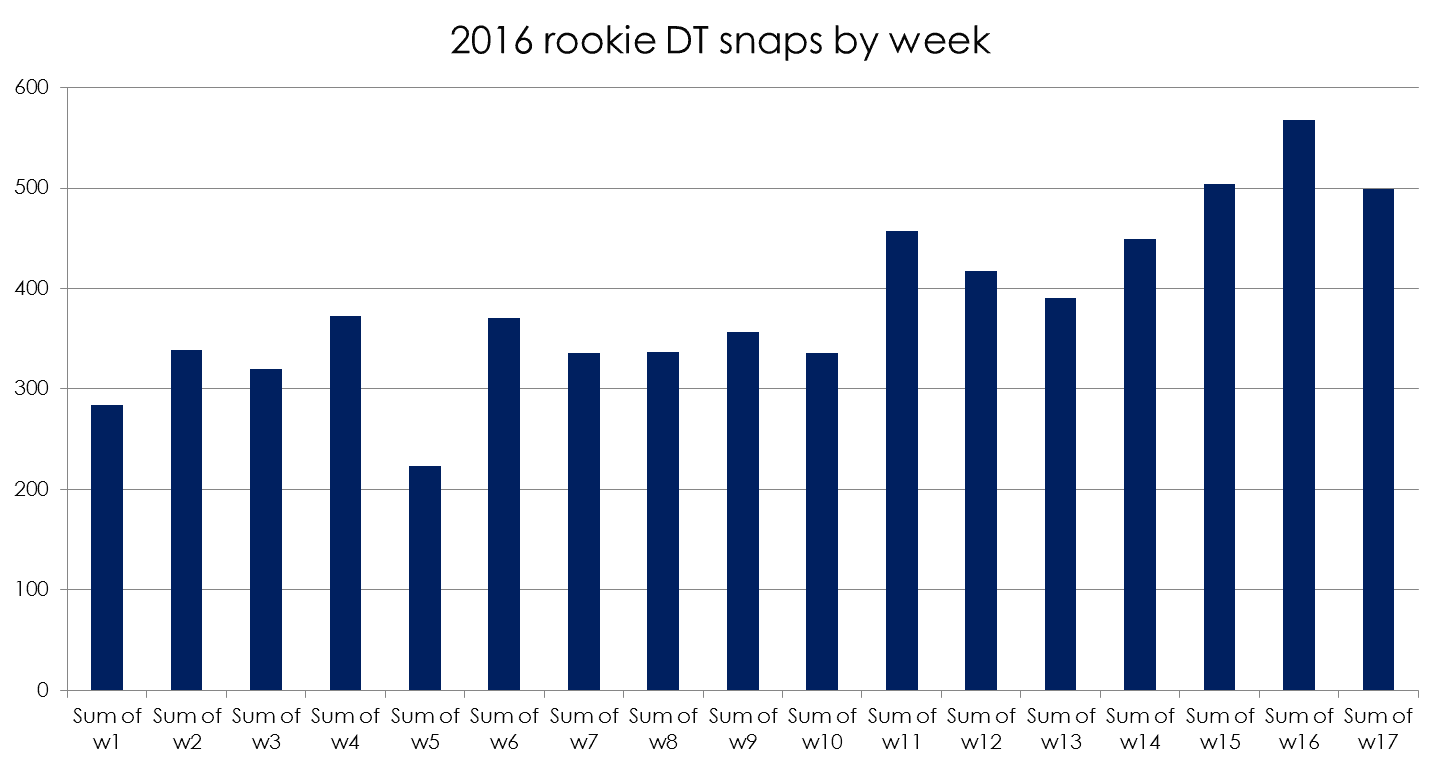
There’s a clear trend here. The rookie DTs played more and more snaps as the season progressed (the drop in week five shows when bye weeks kicked in). The last three weeks of the season showed a combined 500-600 rookie DT snaps per week. This compares to about 2,500 total DT snaps per week so at the end of the year a fifth of all DT snaps were filled by rookies. Let’s see who those players were:
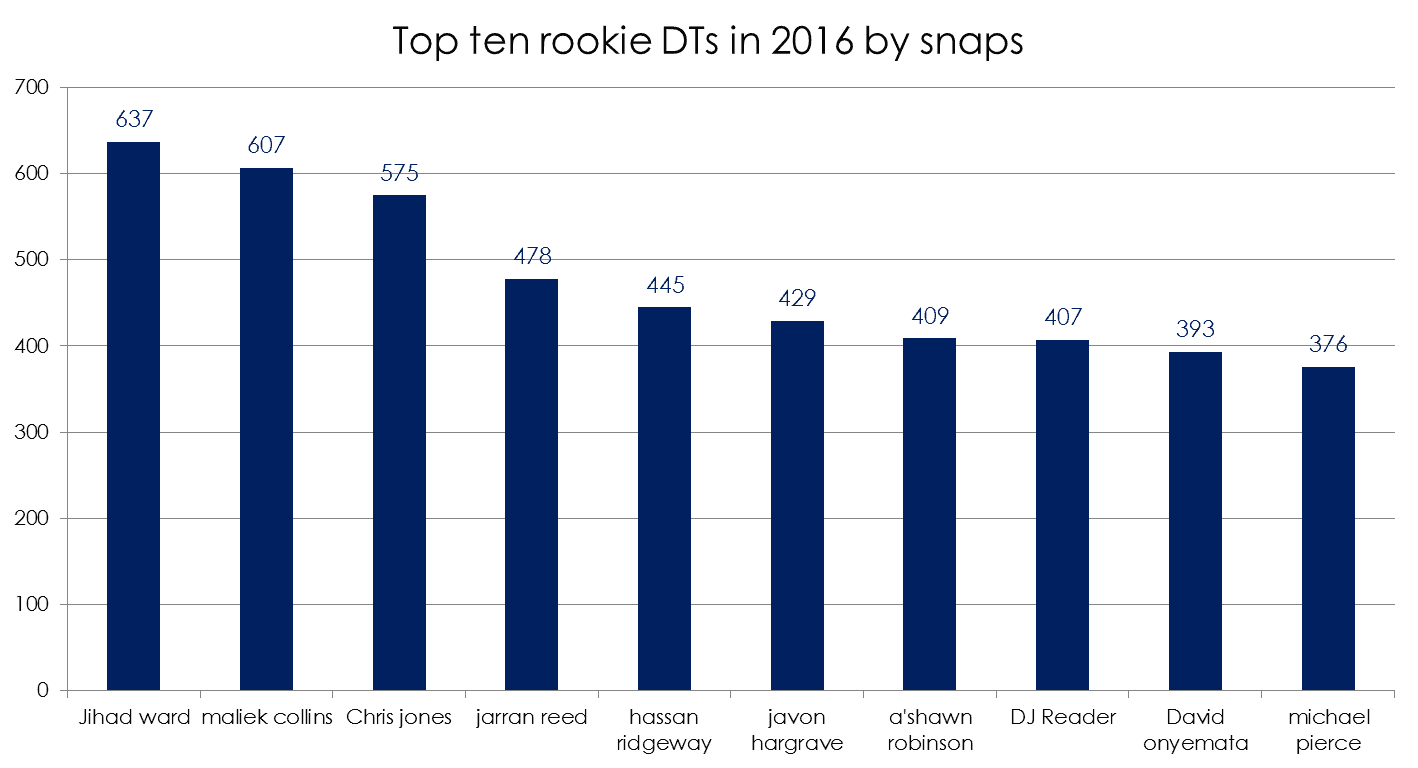
As a comparison, only 32 DTs in 2016 played 500 or more snaps. So the top three players here all had significant seasons (even though Chris Jones was really playing defensive end). Another five players were all significant contributors. Let’s see how productive those top players were:

The top three players in volume are highlighted. As you can see, they were fairly uninspiring in terms of tackles-per-snap. Chris Jones was excellent as a pass rusher, but this chart shows how tough it is to be a truly effective rookie DT.
Defensive Ends
We saw a steadily increasing weekly total for DTs. For DE it looked like this:

So, it was basically the same. DEs totals were very slightly higher, but given that overall there are more ends on the field, this is to be expected. As a check, the weekly total for DE snaps is about 3,500 so actually the proportion is a bit lower here than it was for DT (roughly 15-18%). Again, let’s look at the players who actually played these snaps:
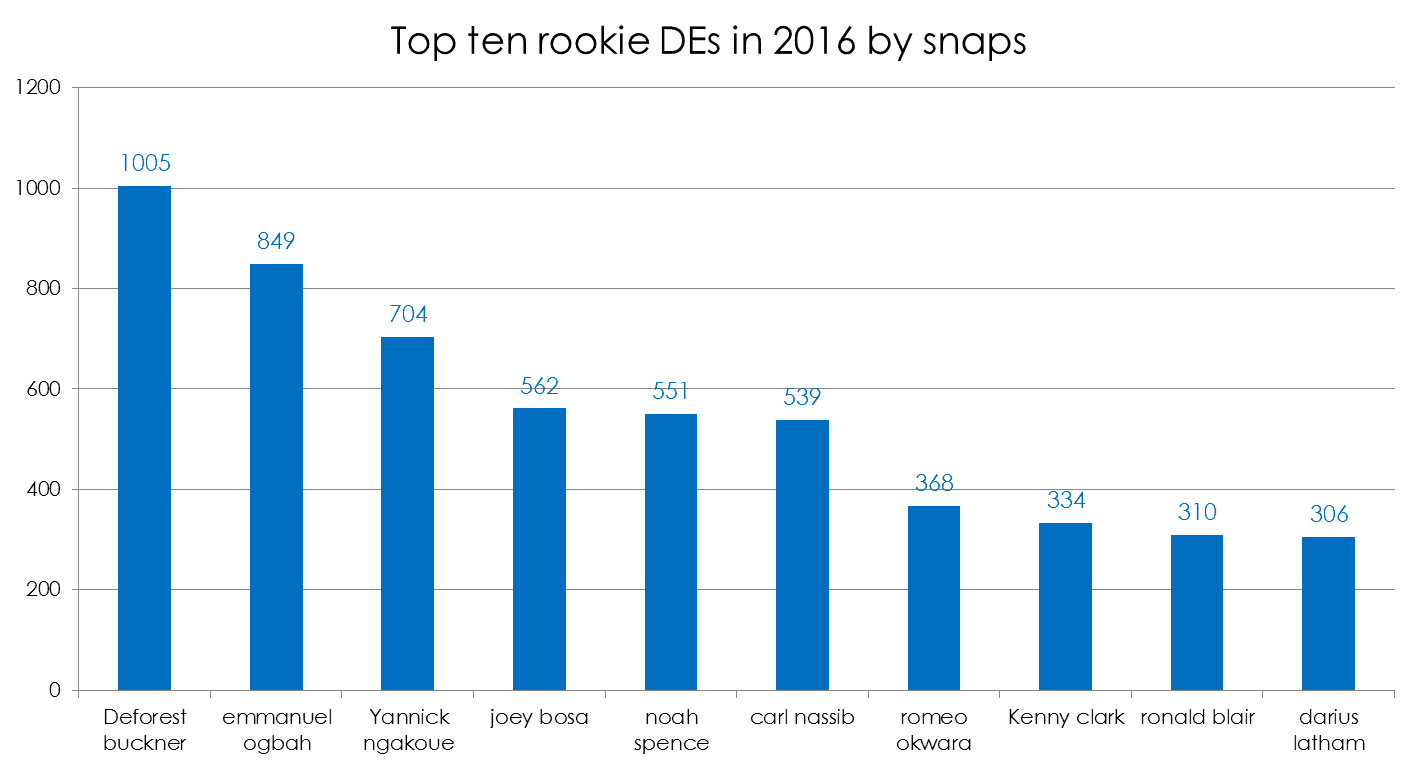
DeForest Buckner was a beast. He actually led the whole league in snaps at his position with an absurd total. He played 84 snaps in a single week and over 70 several times. But we also shouldn’t sleep on Ogbah. His 849 snaps were good enough for ninth in the league. Let’s see how efficient they were with those snaps:

I’ve shown tackles again because they’re much more predictable than sacks. Sacks are such a low-probability event that it’s tougher to predict them. The top three rookies by volume were fairly evenly distributed. But again note that none of them are far above the line of best fit. Buckner produced very well but he had more volume than any other end in the league to do that. His ability to play high volumes is a fantastic asset but it might not be reliable. A man that big playing that much is probably going to get hurt at some point.
Linebackers
So the defensive line classes were pretty good. Here are the snaps at the position most IDP players think is the most important:

This broadly looks similar again – a steady increase. Although you could argue that it’s fairly flat with the last few weeks being a step change ahead in volume. The total LB snap count per week is between 5,000 and 6,000 so actually the percentage here is low. Only about 10% of LB snaps are awarded to rookies. Again let’s see which rookies got those snaps:
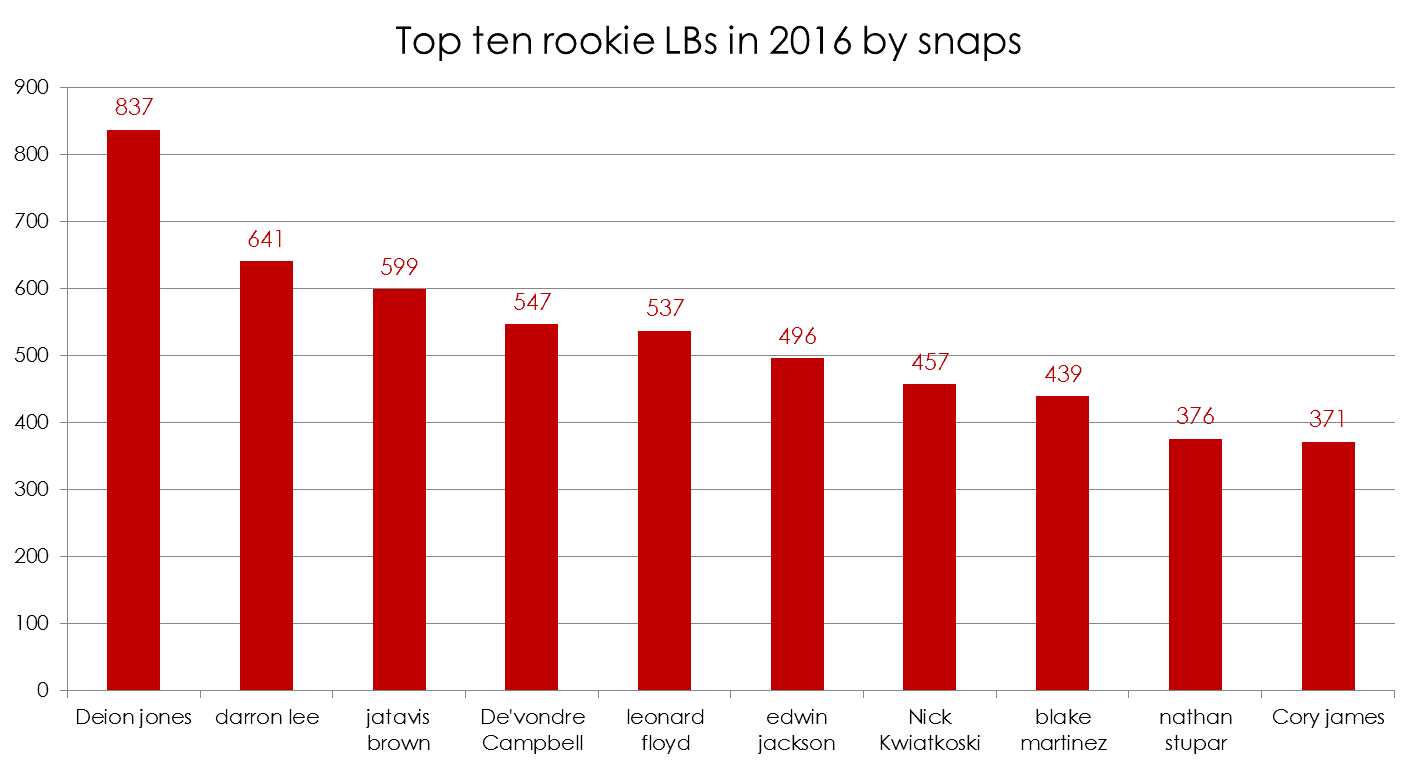
There were two falcons LBs in the top four, with Deion Jones playing around 200 snaps more than any other rookie. He did only come in at number 39 in all LB snaps though. It’s clear that NFL teams did not feel comfortable leaving their rookie LBs on the field much. It’s worth noting Jatavis Brown only played in 12 weeks but I don’t really care about excuses.
Let’s look at efficiency for rookies:
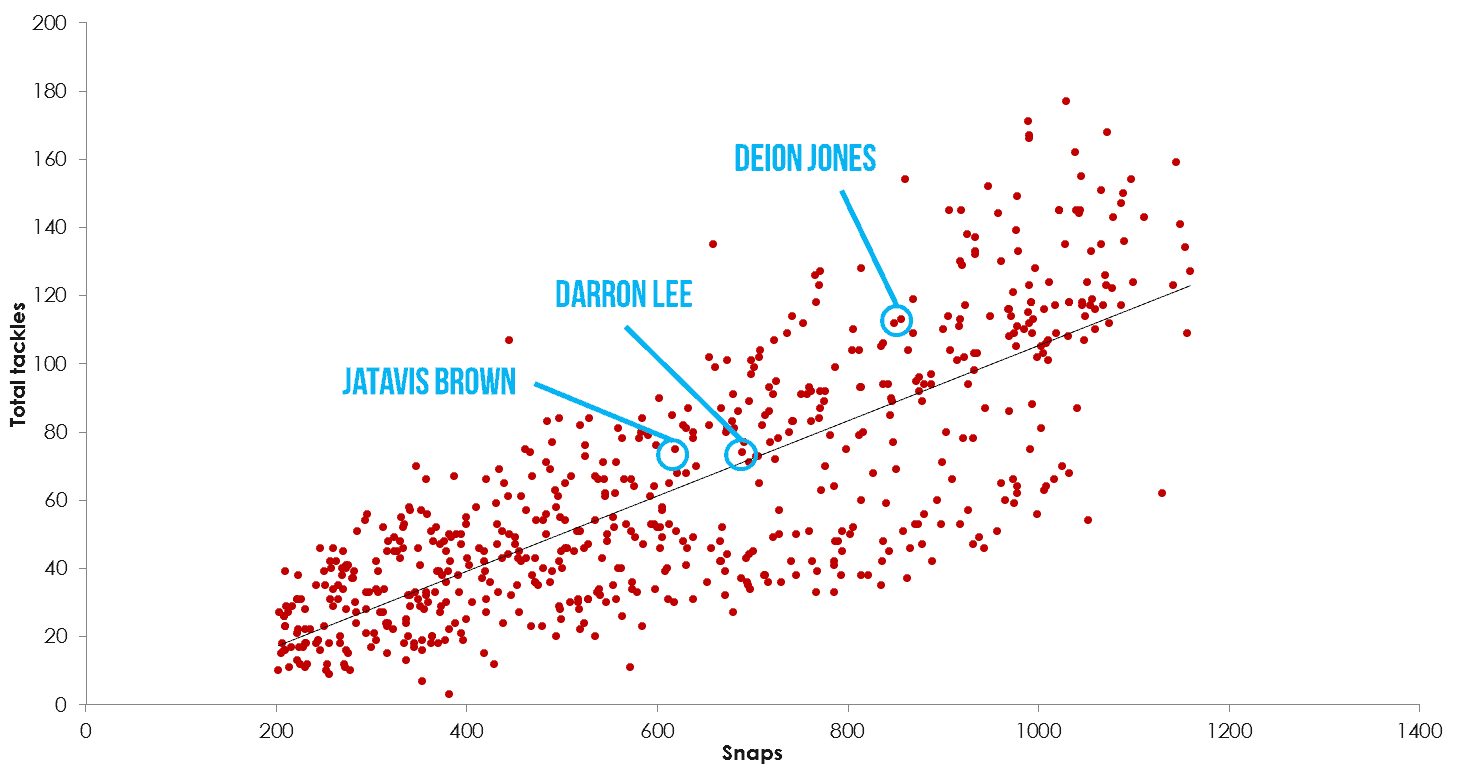
A week or so ago I was involved in a little spat on Twitter when Eric Coleman (@UtahEC) and I were maintaining that rookie LBs generally are not IDP stars. These results back that up for me. The three LBs with the most volume were all barely above the line of best fit. They had okay seasons and may end up being very good indeed, but no rookie LBs were stars regardless of the hype they got. Bear this in mind when you’re getting excited about whichever rookies the Raiders or Saints end up with this season.
Cornerbacks
Last year saw five CBs selected in the first round of the draft. Here’s how the position stacked up over the season:
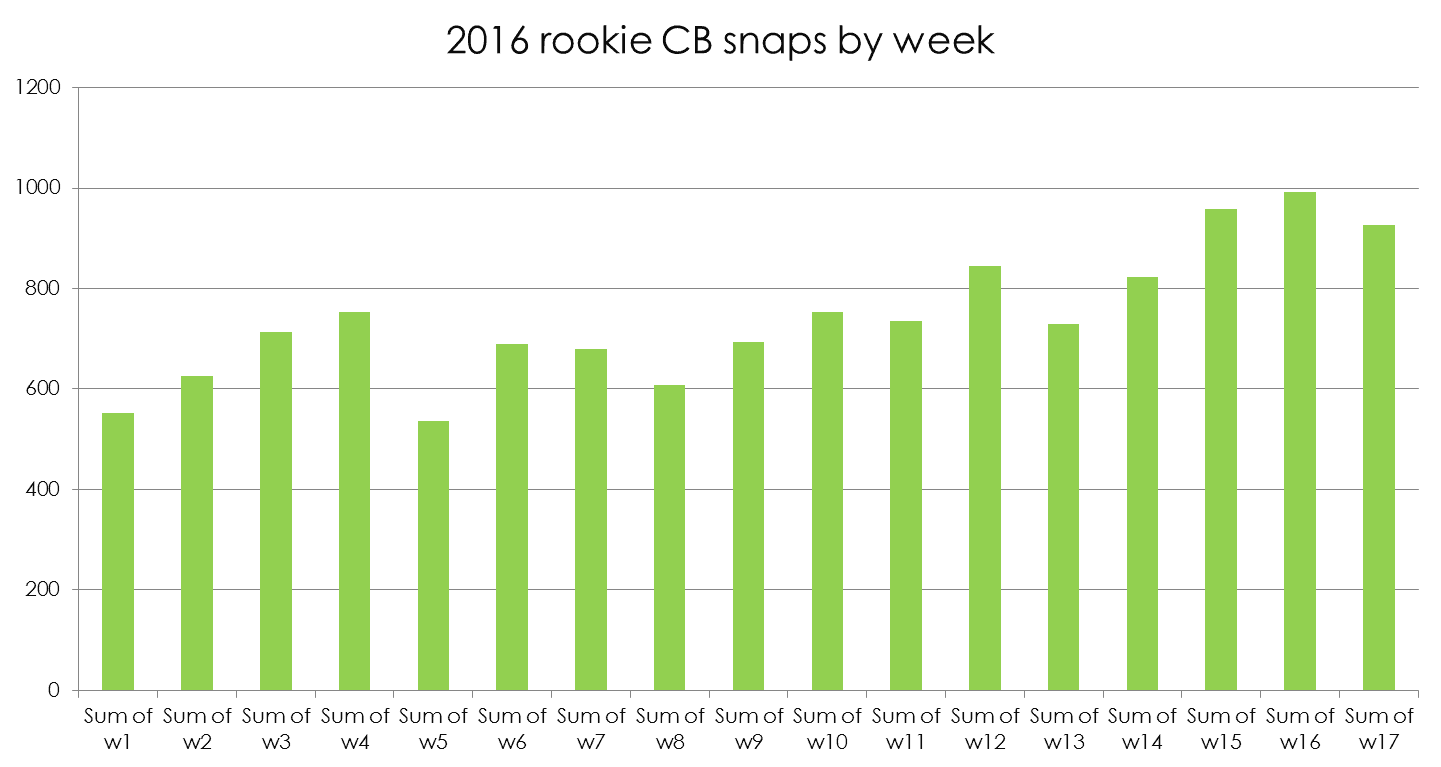
Again, there was a steady increase through the season but notice here how high the numbers are. Even in week two we saw more than 600 rookie corner snaps awarded. There are around 5,000 total CB snaps per week in the NFL so that was 12% already. And by the end of the season rookie corners were playing 20% of the available snaps.
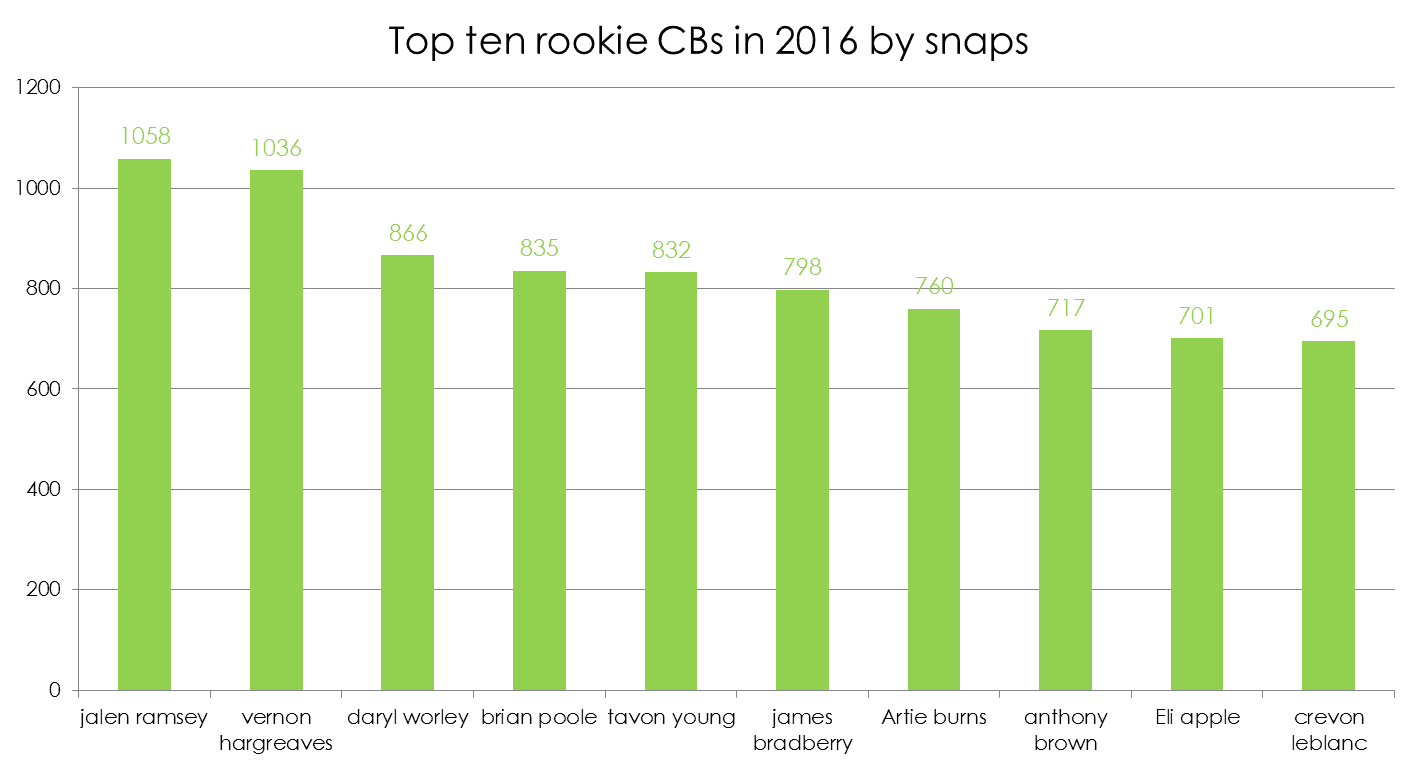
Interesting. I mentioned five were taken in the first round. Daryl Worley, Brian Poole, Tavon Young and James Bradberry were not amongst that number. Coaches seemed much happier to hand out snaps to rookies even though we all know rookie corners can be such a liability. Jalen Ramsey finished at number five amongst all corners. Clearly he’s already established as a top player.
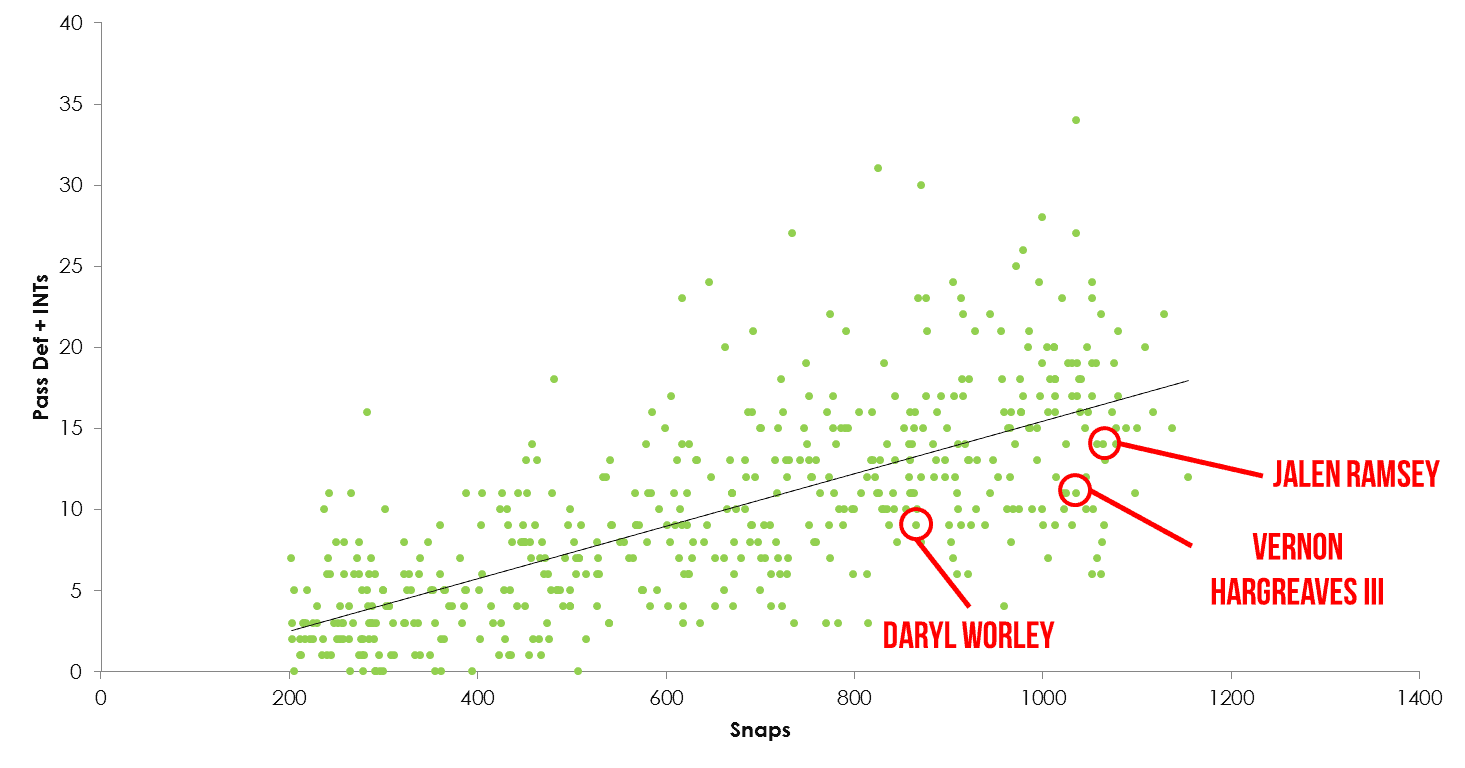
I’ve plotted this against coverage plays (passes defensed and inerceptions) because tackles are a bad stat for corners. This shows far more accurately how good the rookies were in actual quality terms. As you can see none of them were particularly impressive. Ramsey has the look of a budding star but even so he failed to record the number of plays he “should” have given the volume he played. Vernon Hargreaves III and Worley did likewise. They could all become good players, but again rookie corners tend to not be that impressive in NFL terms – even though coaches clearly give them lots of playing time.
Safeties
I was pretty surprised that Keanu Neal and Karl Joseph went as early as they did in 2016. Let’s see how the position shook out:

Finally, a different shape! By week four, rookie safeties were piling up 400 snaps a week and it stayed pretty consistent for the rest of the year. Safeties play a total of around 4,200 snaps per week so rookies accounted for roughly 10%-15% per week.

Neal was the undisputed star here, although 30 other safeties played more snaps than he did across the season. Joseph had injury problems but it’s also worth remembering he was flat out not selected to start the season.
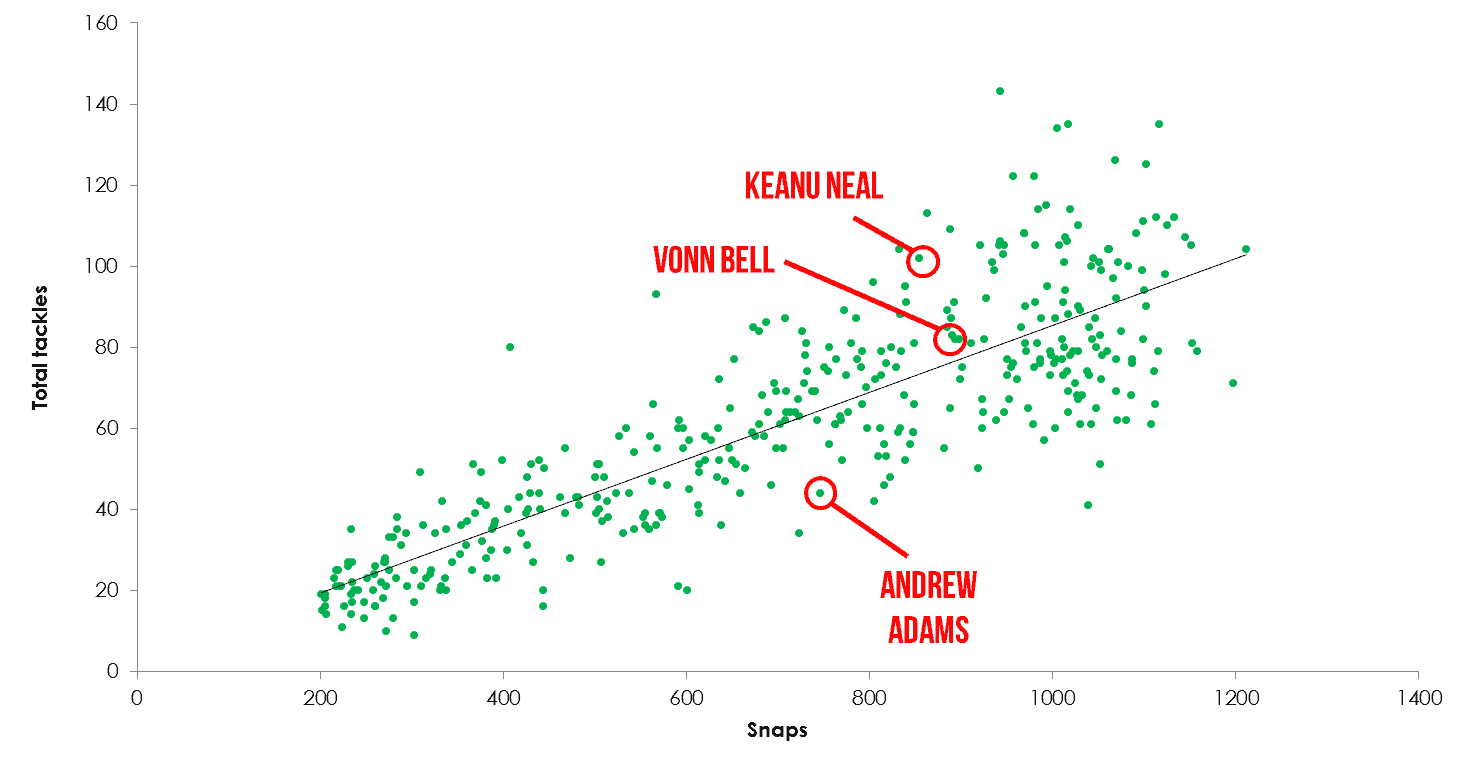
This is good info. We can see that even though Keanu Neal played a pretty solid volume, he was efficient in the tackling game too. Given he was overrated as a tackler and underrated in coverage, this bodes extremely well for him. Vonn Bell was very solid, but Andrew Adams disappointing. You should know that Adams played the deep free safety role behind Landon Collins, and so this is not unexpected at all – just another example showing free safeties tend not to produce as IDPs.
Conclusions
What does this teach us? Firstly, that overwhelmingly NFL coaches use rookies more as the season progresses. This is such a similar trend across all positions that I’m very confident it amounts to normalisation. Looking at all the positions together looks like this:
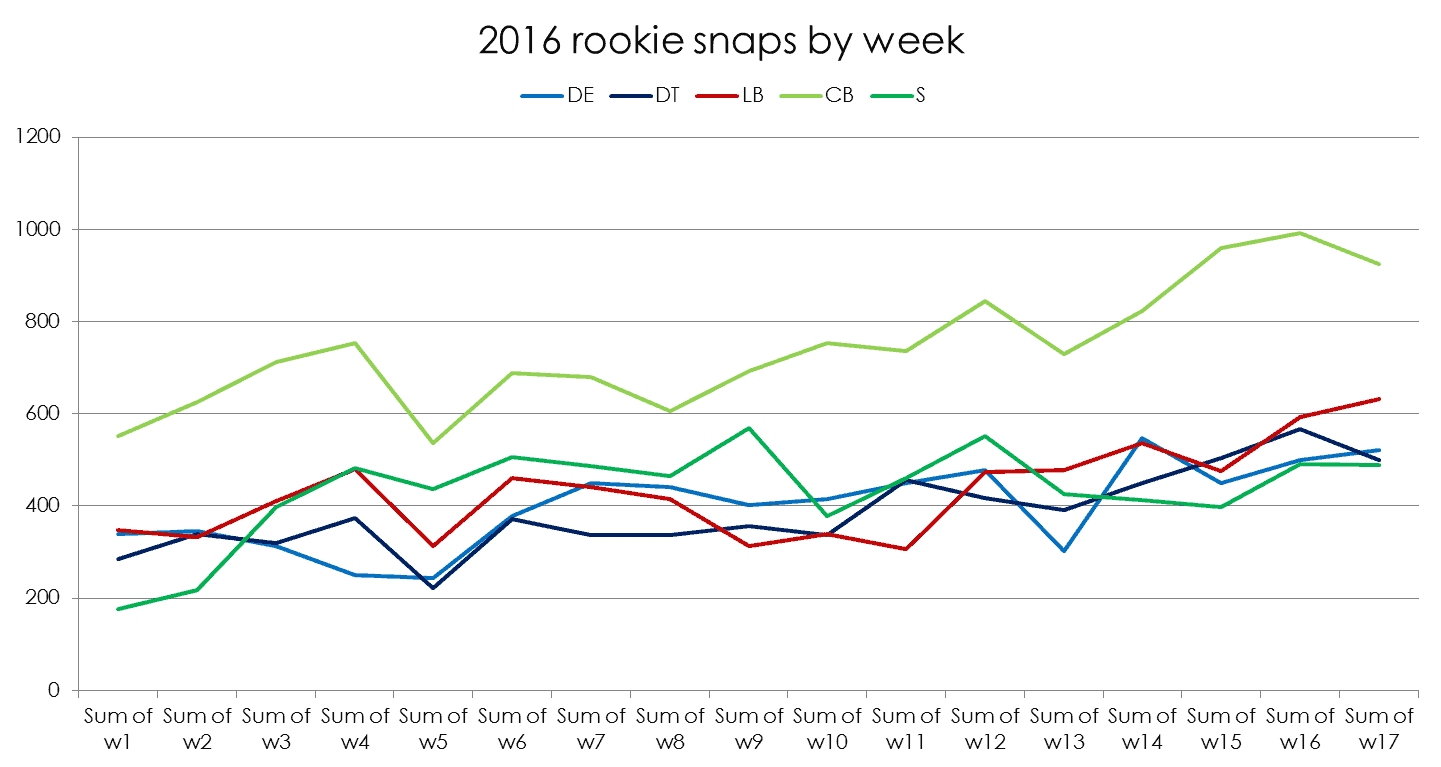
Frankly I’m not sure how much clearer that could be. There’s a couple of possible reasons behind this trend:
- As injuries pile up for veterans, coaches are forced to play rookies more.
- Rookies learn more on the job and are more ready to play later on.
I don’t really care what the reason is. The important point is that even if my rookies don’t immediately play there’s a good chance they will do so later in the year.
Secondly I think it’s clear that (from 2016 at least) coaches are less keen at some positions (notably LB and S) to throw rookies in and more keen at other positons (DT and CB). This could well be a facet of the 2016 rookie class’s relative strength but it’s worth considering ahead of 2017.
Lastly I think we can see (even with the limited examples of an article like this) that rookies tend to not be very good in NFL or efficiency terms. For every example of a really good rookie I can give you three underwhelming ones. And that’s not likely to change anytime soon. The difference in the game and the learning curve demands a big adjustment.
Just like you, I’m really excited about my rookie drafts and gathering talent for my teams. But it’s important to balance that excitement with reality. If your leaguemates all start jumping on IDPs early, then hold fire. Every roster spot taken up by a mid-round non-productive LB is an extra veteran sitting on the waiver wire for you to grab – and they are far more likely to be a real asset for your team.
Enjoy your rookie drafts everyone!
[/am4show]
- Ten IDP Fantasy Football Stats You Need to Know after Week 16 - December 29, 2023
- Ten IDP Fantasy Football Stats You Need to Know after Week 15 - December 22, 2023
- Ten IDP Fantasy Football Stats You Need to Know after Week 14 - December 14, 2023


































































